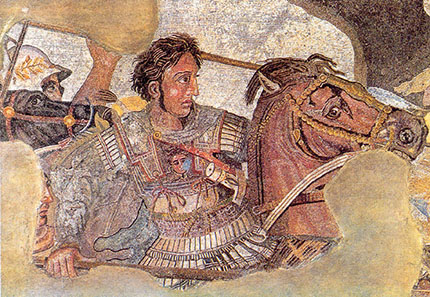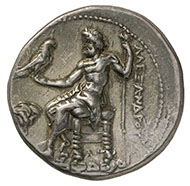Human Faces Part 7: Alexander the Great
with the kind permission of the MoneyMuseum, Zurich.
Why is it that for centuries – or rather thousands of years – the head has served as the motif for the side of a coin? And why has this changed in the last 200 years? Ursula Kampmann poses these questions in her book ‘MenschenGesichter,’ from which the texts for our new series are taken.
Alexander in a battle in the depiction of the so-called Alexander mosaic from Pompeii. Photo: Ruthven / Wikipedia.
When Alexander, later to be known as ‘the Great,’ set out to conquer the Persian Empire, the 70 talents of silver in his treasury were offset by 200 talents of debts. He had used this money to purchase supplies for his army. These supplies would only last 30 days – a rather tight timeframe in which to conquer a global empire! But Alexander was fated to succeed. In fact, the loot from his victory at Granicus in May of 334 BC furnished him with the means to finance his campaign worry-free from then on.
Alexander III, King of Macedonia (336–323 BC). Drachm, Sardis, 332-323 BC. Head of Heracles with lion scalp, facing right. Rev. Zeus upon his throne, facing left, an eagle upon his outstretched right hand; in the left field, the mint mark kantharos. © MoneyMuseum, Zurich.
This first victory provided Alexander with access to the wealthy cities that had until then been part of Persian controlled Asia Minor. After conquering Sardis and Tarsus in the year 333 BC, it seems Alexander introduced his own distinct design for his silver coins and launched a coinage that put anything that had come before it to shame. For the obverse, he chose Heracles, the patriarch of his lineage, who was regarded as the champion of good versus evil, and was worshipped personally by Alexander.
Alexander is said to have gotten his hands on more than enough silver for his coins: Susa yielded him 50,000 talents of silver, while Persepolis and Ekbatana yielded 120,000 and 180,000, respectively.
With that last amount alone, Alexander could have minted – using a calculation of one talent per 6,000 drachms – 1,080 million drachms like the one depicted here, or 270 million tetradrachms. Comparing these sums in relation to the costs that today’s researchers calculate for his campaign: It’s estimated that Alexander’s army needed 20 talents of silver per day, so a total of 7,500 talents per year. All told, the entire campaign against the Persians is estimated to have cost 80,000 talents.
Alexander’s coins spread throughout the entire then-known world by way of his soldiers. The familiarity of the coins and their consistent weight made them a popular means of payment in long-distance trade. Soon, ‘free’ cities were issuing coins in Alexander’s name, even without the royal commission bid.
Right until the 1st century BC, coins were minted according to the prototype of Alexander’s tetradrachms and drachms. This means that die cutters were cutting new stamps at a time when it was no longer conceivable that a ruler wouldn’t want to have his portrait on a coin. As a result, many artists endowed Heracles with Alexander’s features. This created a paradoxical situation, wherein coins issued during Alexander’s lifetime do not feature his portrait, while later pieces do bear some portrait resemblance.
In the next chapter, you’ll learn about the significance due to Alexander the Great’s mortal remains.
All sections of the series can be found here.
The book ‘MenschenGesichter’ is available in printed form from the Conzett Verlag website where you can find it as an ebook too. It soon will be translated to English.










